A Complete Guide to Growing, Planting, Pruning and Caring for a Plum Tree in the UK
A Complete Guide to Growing, Planting and Caring for a Introducing the Plum Tree in the UK
 blossoming plum trees at Meadows park, Edinburgh
blossoming plum trees at Meadows park, Edinburgh
Could you imagine having a vibrant and luscious plum tree in your garden? Plums are among the most magical varieties of fruit trees, with their lush foliage and delicious fruits – so why not have one in your own garden this season? Growing, planting and caring for plum trees can be an enjoyable experience. In this comprehensive guide we'll cover everything from where to source plum trees, how to plant them correctly, how to tend them throughout the seasons right through until harvesting plump ripe plums ready for eating! So what are you waiting for? Let's get started on creating your very own edible masterpiece!- Facts and Figures
The Plum Tree is one of the most beloved fruit trees in the world, and it's easy to see why. With its beautiful white blooms in the spring and delicious, juicy fruit in the summer, it's a tree that can be enjoyed by all. Interestingly, there are over 2,000 different varieties of plum trees, each with their own unique flavor and attributes. Some are sweet, others tart, and some even have hints of almond or honey.
Additionally, plum trees are quite hardy and can grow in a variety of climates, making them a popular choice for gardeners all over the world. Whether you're a seasoned garden pro or a beginner, the Plum Tree is definitely worth considering.
The History of the Plum Tree in the UK
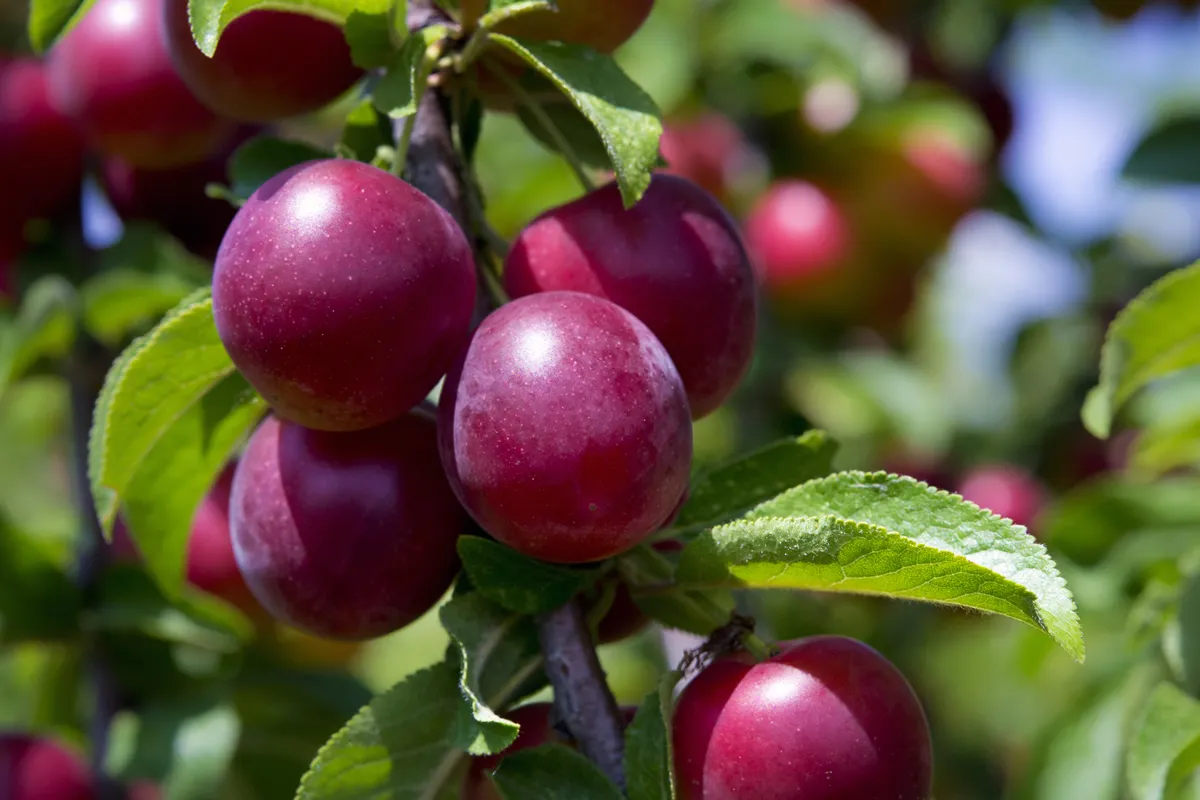 Red ripe plums on the tree
Red ripe plums on the tree
The history of the plum tree in the UK is quite fascinating. Originating in Iran, plums were brought to Britain from Asia. Once introduced, they became a popular fruiting tree across the region.
Plum trees, or Prunus Domestica, have a long history as one of the most treasured fruit trees in the United Kingdom. They not only add a striking appearance to the landscape, but also produce delicious and versatile fruits. The trees themselves are small broadleaf, deciduous trees or sometimes shrubs, with dark-brown bark. The branches grow straight and twigs are often spiny in wild plants.
One of the most famous varieties of plum in the UK is the Victoria Plum. This cultivar started appearing in England in the 1840s and has since become one of the most popular fruiting plum trees in the country. It was widely cultivated in the UK from 1847 onwards and was awarded a First Class Certificate by the RHS in 1973, as well as an Award of Garden Merit.
The Victoria Plum likely originated from the Suffolk village of Alderton where the Gage family, known for breeding many plums, resided. Other early varieties grown at the beginning of the 20th century included the variety raised in 1831 by Thomas Thorpe, a handloom weaver on Lord Suffield's estate at Middleton, near Manchester.
Today, you can even purchase 'Victoria' plum trees from specialist family run nurseries, with online purchases benefiting UK conservation charities. Plums continue to be a cherished part of the UK's horticultural landscape.
Understanding Variations of Species of Plum Tree ideal for UK Conditions
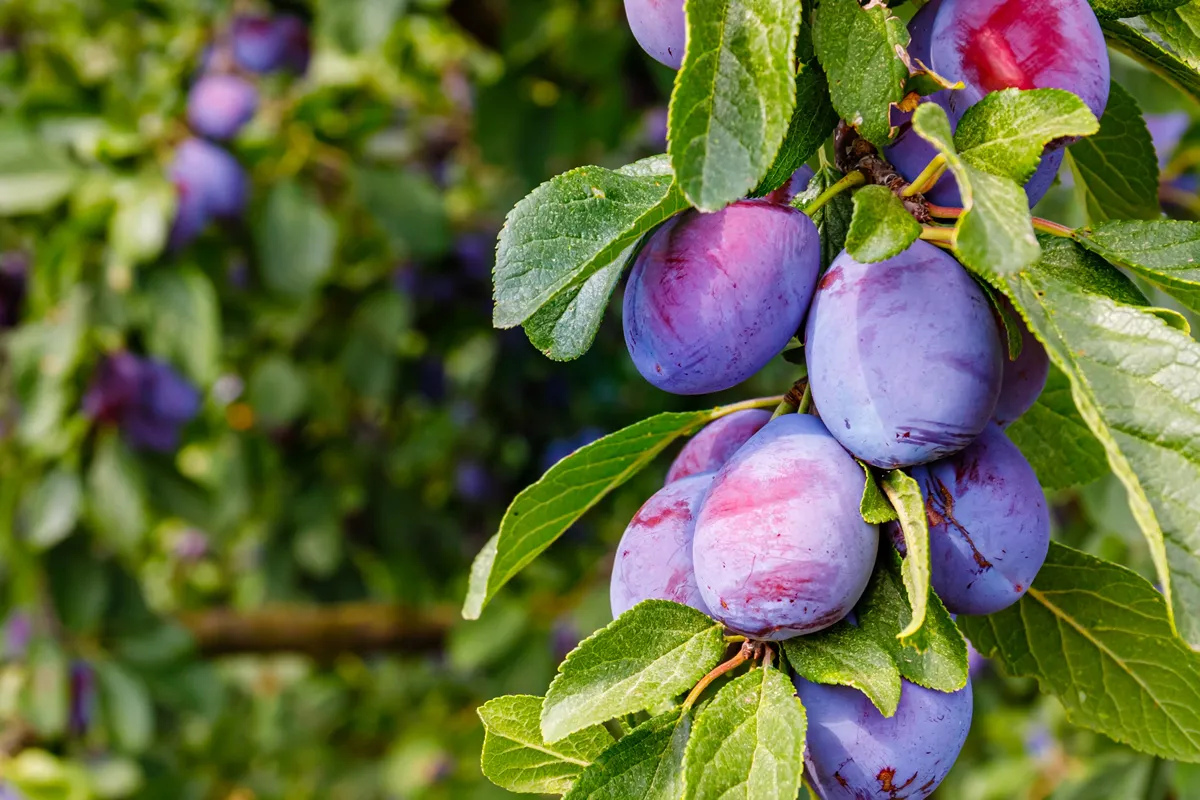 Ripe blue purple plums in the plum garden. Ripe plums in orchard.
Ripe blue purple plums in the plum garden. Ripe plums in orchard.
The beautiful plum tree is a popular choice amongst gardeners in the UK, known for its stunning blossom displays and delicious fruits. However, with so many variations of plum tree species available, it can be difficult to know which one to choose for UK conditions. But fear not, with some understanding of the different types of plum tree and their ideal growing conditions, you can confidently select the perfect variety for your garden. From the hardier European plum to the juicy Japanese plum, there is a species to suit every preference. With a little research, you can find the perfect plum tree to thrive in your garden and provide delicious fruits for years to come.
Sure, let's delve into some of the plum tree varieties which are best suited for growth in the UK!
- Victoria: This is arguably the most popular plum variety in the UK. They're easy to grow and known for their hardiness. Victoria plums thrive in well-drained soil and full sun exposure. The fruit is juicy and sweet, making it perfect for eating fresh or using in culinary creations. They're also quite disease-resistant.
- Blue Tit: Blue Tit plums are known for their compact growth habit, perfect for smaller gardens. They require full sun and well-drained soil, and they're resistant to most common plum diseases. The fruit is sweet and excellent for fresh eating.
- Avalon: Avalon plums produce large, juicy fruits. They prefer a sunny position and a well-draining soil. They are resistant to disease and have a vigorous growth habit.
- Cambridge Gage: This variety is similar to a greengage but is easier to grow. It thrives in well-drained soil and full sun. The fruit is sweet and excellent for fresh eating, cooking, and making jam.
- Opal: An early-ripening variety, Opal plums are small but pack a flavorful punch. They prefer well-drained soil and full sun. They're also quite hardy and resistant to disease.
- Marjorie's Seedling: This is a late-season variety, known for its heavy cropping and disease resistance. The plums are juicy and sweet, making them perfect for desserts. They thrive in well-drained soil and full sun.
- Belle de Louvain: This variety is known for its large, sweet, and juicy fruits. It's an excellent choice for colder areas as it's quite hardy. Belle de Louvain plums prefer well-drained soil and a sunny position.
- Purple Pershore: This plum variety is incredibly hardy and can withstand cold temperatures, making it a great choice for northern or exposed areas. The plums are excellent for cooking and making jam.
Remember, while these varieties are known for their hardiness and suitability for the UK climate, specific growing conditions can vary. It's always a good idea to consult with a local nursery or extension service to ensure you're choosing the best variety for your specific location and soil conditions. Happy gardening!
Growing a Plum Tree From Seed
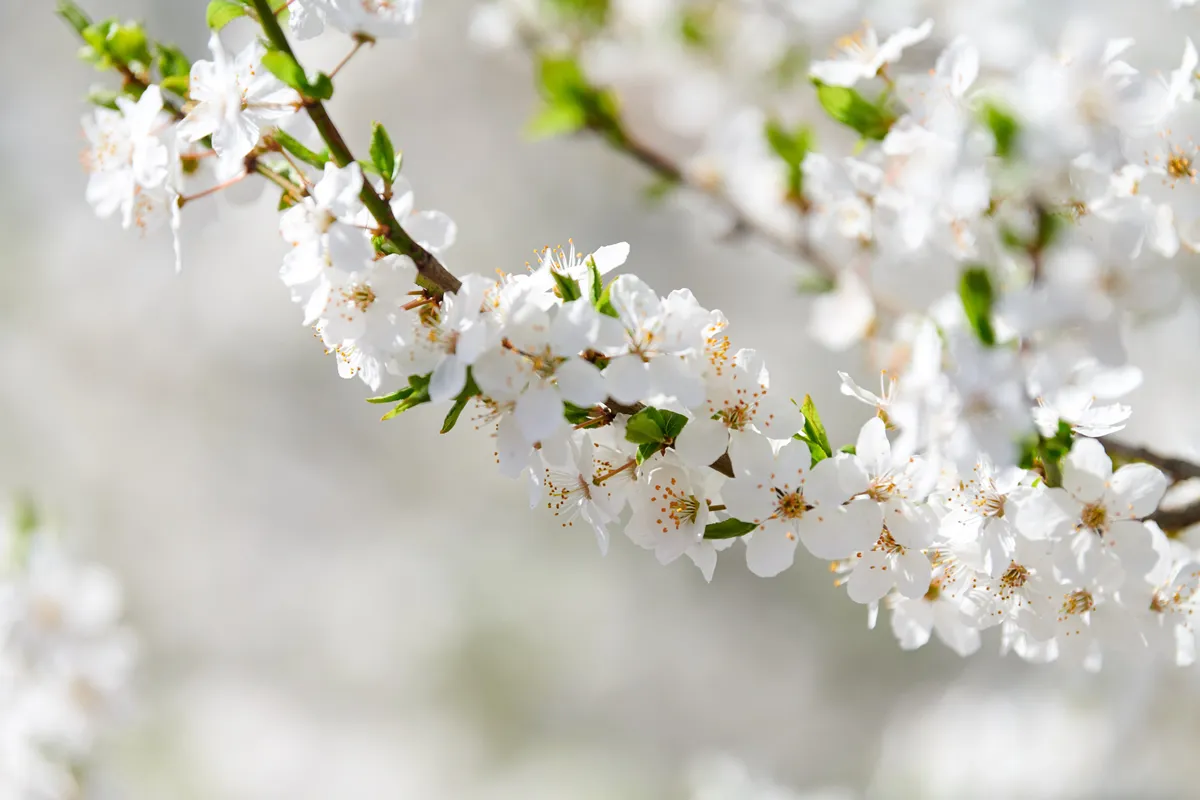 White plum blossom, beautiful white flowers of prunus tree in city garden, detailed macro close up plum branch. White plum flowers in bloom on branch, sweet smell with honey hints
White plum blossom, beautiful white flowers of prunus tree in city garden, detailed macro close up plum branch. White plum flowers in bloom on branch, sweet smell with honey hints
If biting into a juicy plum that you grew from a seed sounds appealing, then keep reading! Growing a plum tree from seed isn't the easiest task, but the rewards are worth it. Firstly, select a high-quality plum fruit with a ripe and healthy seed. Once you've removed the pit, you'll need to clean it and allow it to dry out for a few days. Plant the seed in nutrient-rich soil and keep it in a warm and sunny spot. Don't forget to water it regularly! In a few weeks, a green shoot should appear, and you can finally begin to call yourself a plum tree parent. As your little tree grows, it will likely face some setbacks, but with the right care and attention, you'll be harvesting your own delicious plums in just a few short years.
Growing a plum tree from seed in the UK can be a delightful and fulfilling gardening project. Here's an enthusiastic step-by-step guide to help you do it right!
- Step 1: Choose the Right Plum Start by choosing a local variety of plum that's already proven to thrive in your climate. The Victoria plum, for example, is a popular choice in the UK.
- Step 2: Extract the Seed Enjoy a ripe plum and save the pit. Rinse it well to remove all fruit residue, as this could lead to mould.
- Step 3: Test the Seed Place the cleaned seed in a glass of water. If it sinks, it's viable and ready to plant. If it floats, it's likely not going to germinate and you should try with another pit.
- Step 4: Stratify the Seed Stratification mimics the natural winter conditions that plum seeds need to break dormancy. Wrap your plum pit in a damp paper towel, place it in a sealed plastic bag, and put it in the fridge. Keep it there for 6-8 weeks.
- Step 5: Plant the Seed After stratification, plant your seed about 3 inches deep in a pot filled with soil. The pot should have good drainage to prevent waterlogging.
- Step 6: Care for Your Seedling Keep the soil moist, but not soaking. Place the pot in a sunny spot, like a south-facing window, and wait for your seed to sprout. This could take anywhere from 1-3 months.
- Step 7: Transplant Your Seedling Once your seedling is about a foot tall, it's ready to move outdoors. Choose a sunny spot in your garden with well-draining soil. Dig a hole twice as wide and just as deep as your pot. Place your seedling in the hole, backfill with soil, and water it well.
Remember, patience is key! It will take a few years for your tree to start producing fruit, but the wait will be worth it when you're enjoying your very own home-grown plums. Happy planting!
How to Propagate a Plum Tree
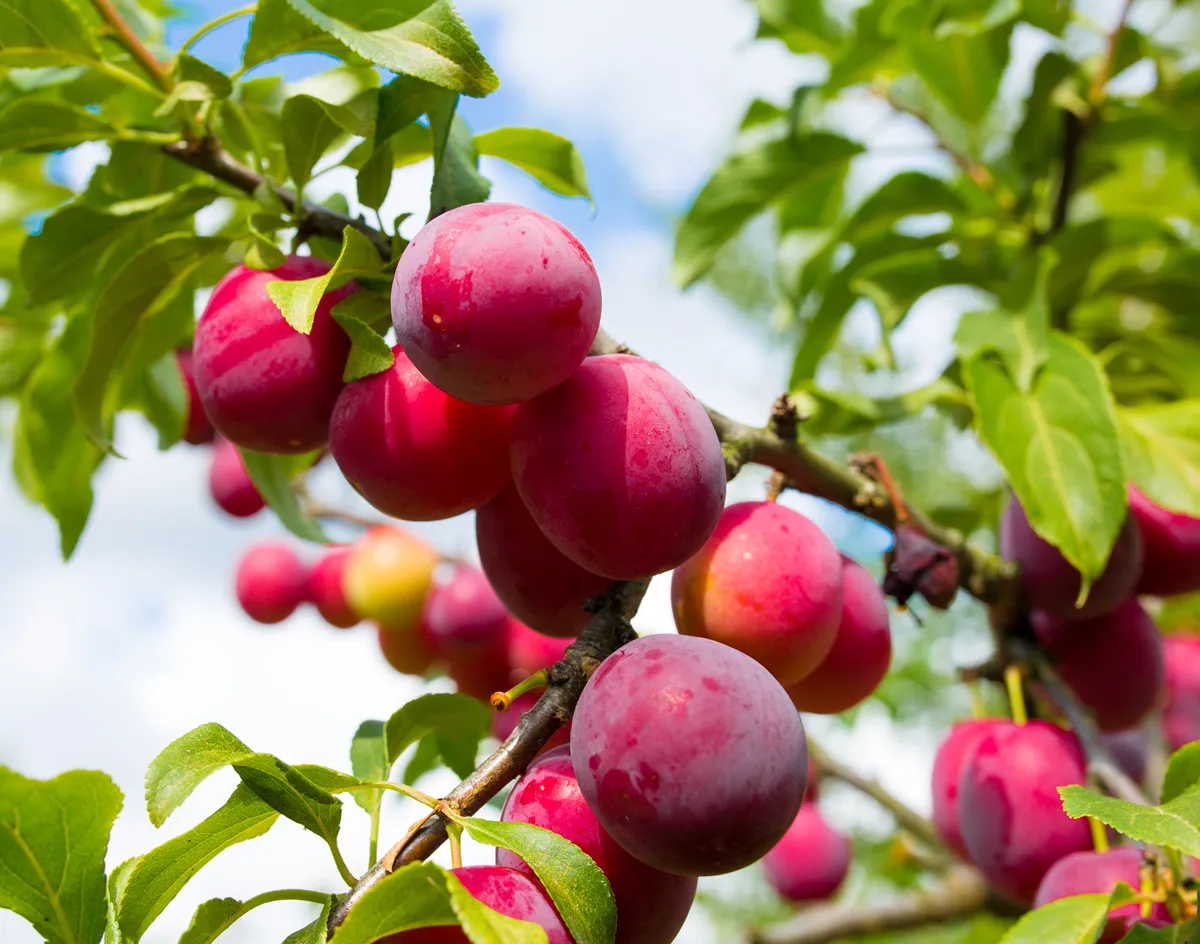 juicy plum on a young tree, purple, fruits
juicy plum on a young tree, purple, fruits
If you're looking to grow a thriving plum tree, propagating it is a great way to get started. First, select a healthy tree and take a cutting from it in late summer or early fall. You'll want to choose a branch that is at least a foot long and has several buds on it. Make a clean cut using sharp pruning shears. Next, remove all but the top two or three leaves, and dip the cut end of the cutting into rooting hormone powder. Place the cutting in a pot filled with well-draining soil and keep it moist. After a few months, check for root growth by gently tugging on the cutting. Once you notice new growth, you can transplant your new plum tree to its permanent home in the ground. With a little patience and care, you can enjoy the fruits of your labour for years to come!
Certainly! Propagating a plum tree using the cutting method can be a rewarding process. Here's a step-by-step guide to get you started:
- Step 1: Choose the Right Time The best time to take cuttings from a plum tree is in late winter or early spring when the tree is still dormant but getting ready to break dormancy.
- Step 2: Select a Healthy Branch Choose a healthy, disease-free branch from last year's growth. It should be about pencil-thick and have several nodes (bumps where leaves or branches sprout).
- Step 3: Prepare the Cutting With a sharp, sterilized pruning shear, cut a piece around 6-8 inches long. The cut should be made just below a node at a 45-degree angle.
- Step 4: Treat with Rooting Hormone Dip the bottom end of the cutting in a rooting hormone. This encourages root development and can increase the cutting's chances of success.
- Step 5: Plant the Cutting Fill a pot with a mix of half perlite and half peat moss. Insert the treated end of the cutting into the soil, ensuring that at least one node is under the soil level. Water thoroughly.
- Step 6: Create a Humid Environment Cover the pot with a clear plastic bag to create a greenhouse-like environment. This helps maintain humidity which is crucial for root development.
- Step 7: Place in the Right Location Put the pot in a warm place with indirect light. Too much direct sunlight can cause the cutting to dry out.
- Step 8: Monitor and Wait Keep the soil moist, but not soggy. In about 6-8 weeks, the cutting should start developing roots. You can gently tug on the cutting; if you feel resistance, it means roots are forming.
- Step 9: Transplant Once the cutting has established a good root system, you can transplant it into a larger pot or directly into the garden.
Remember, propagation by cuttings can be a bit hit-and-miss. Don't be discouraged if your first attempt doesn't work out - even experienced gardeners often need a few tries to get it right. Happy propagating!
Choosing the Right Location to Plant Out your Plum Tree
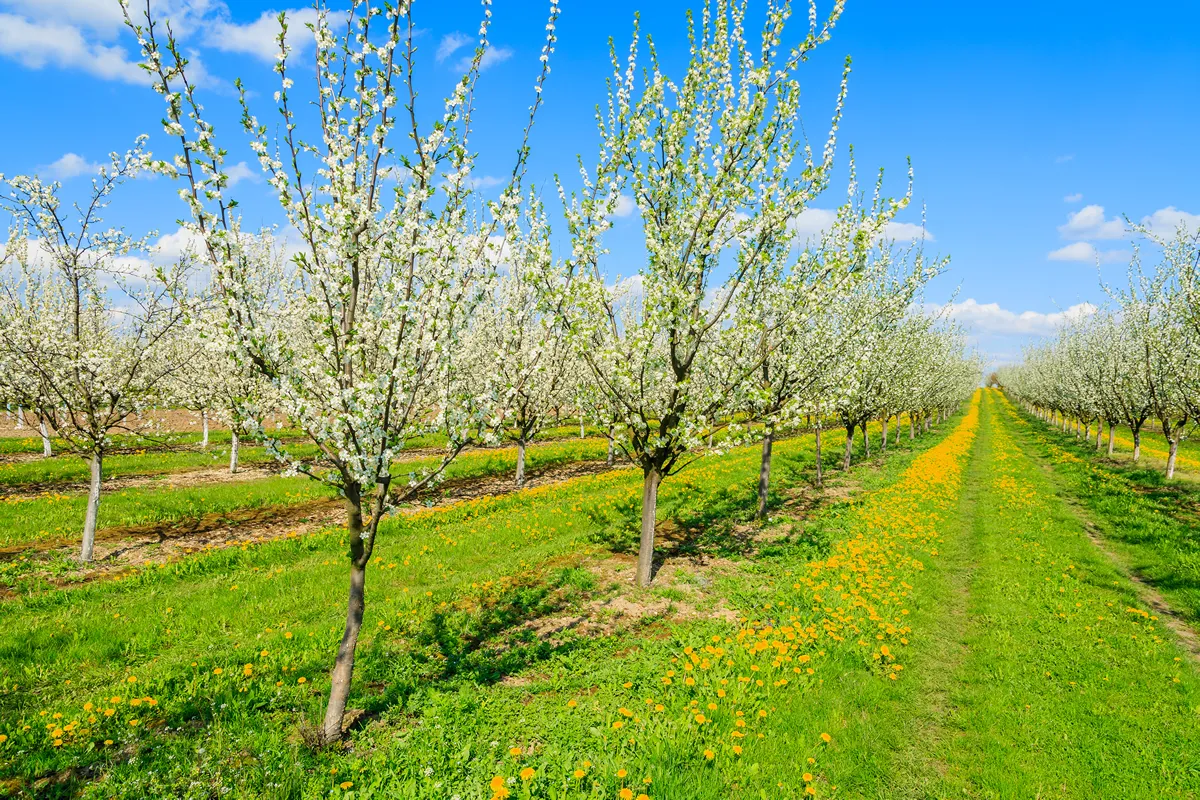 Plum trees in blossom in an orchard
Plum trees in blossom in an orchard
Planting a plum tree in your garden can be a beautiful addition to your landscape, but it's important to choose the right location to ensure the tree thrives. When considering the location, you want to think about factors such as sunlight, soil quality, and drainage. Plum trees thrive in areas where they can get partial, or full, sunlight, preferably six hours or more per day. The soil should also have good drainage, as plum trees don't do well in areas with standing water.
Additionally, the soil should be fertile and have a pH level between 6.0 and 7.5. By taking these factors into account, you can give your plum tree the best chance to grow and produce delicious fruits for years to come.
When Do you Plant Out out a Plum Tree?
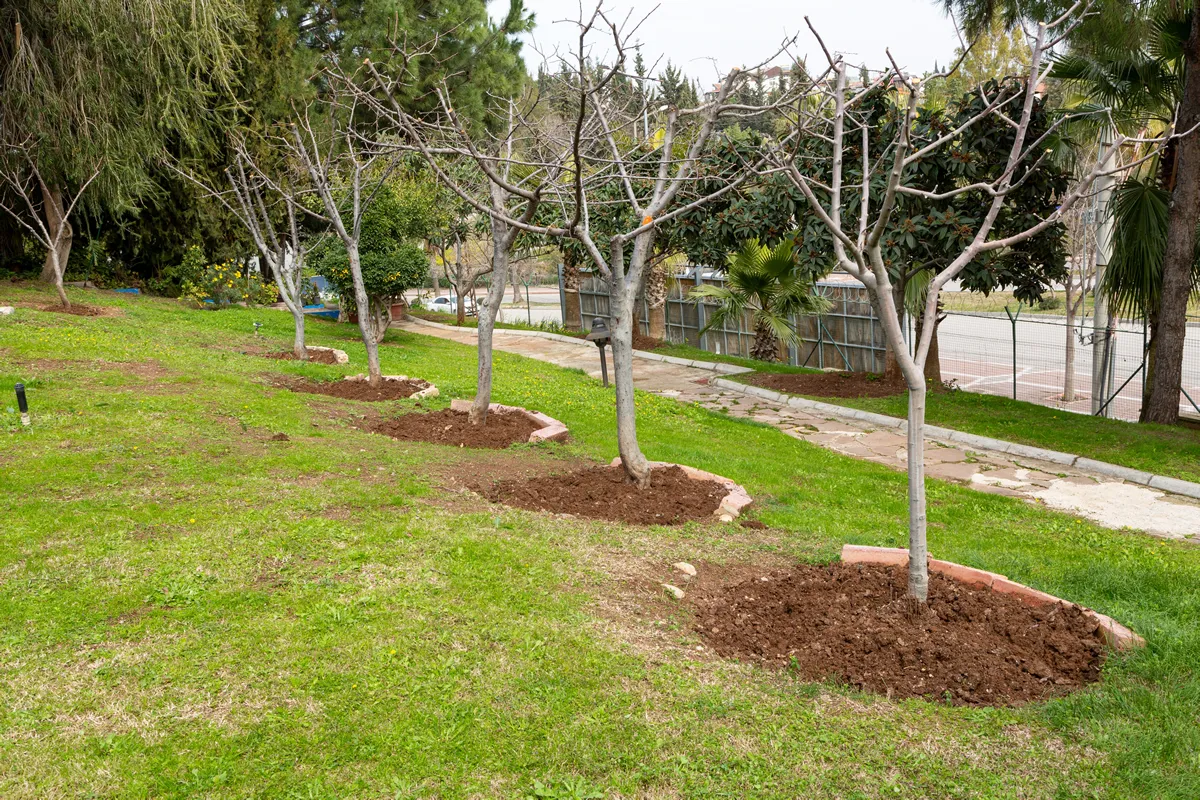 Pruned fruit trees in a garden.
Pruned fruit trees in a garden.
Spring is the perfect time to plant out a plum tree. The soil is warmer and more conducive to growth, giving the tree a strong start. It's important to choose a sunny location with well-draining soil, and to dig a hole deep and wide enough to accommodate the root system. When planting, be sure to handle the root ball carefully and backfill the hole with soil, adding compost or fertilizer if necessary. With regular watering and care, your plum tree will thrive and produce delicious fruit for years to come. Don't wait too long to plant - start planning now for a bountiful harvest in the years ahead!
Preparing the Soil for Planting a Plum Tree
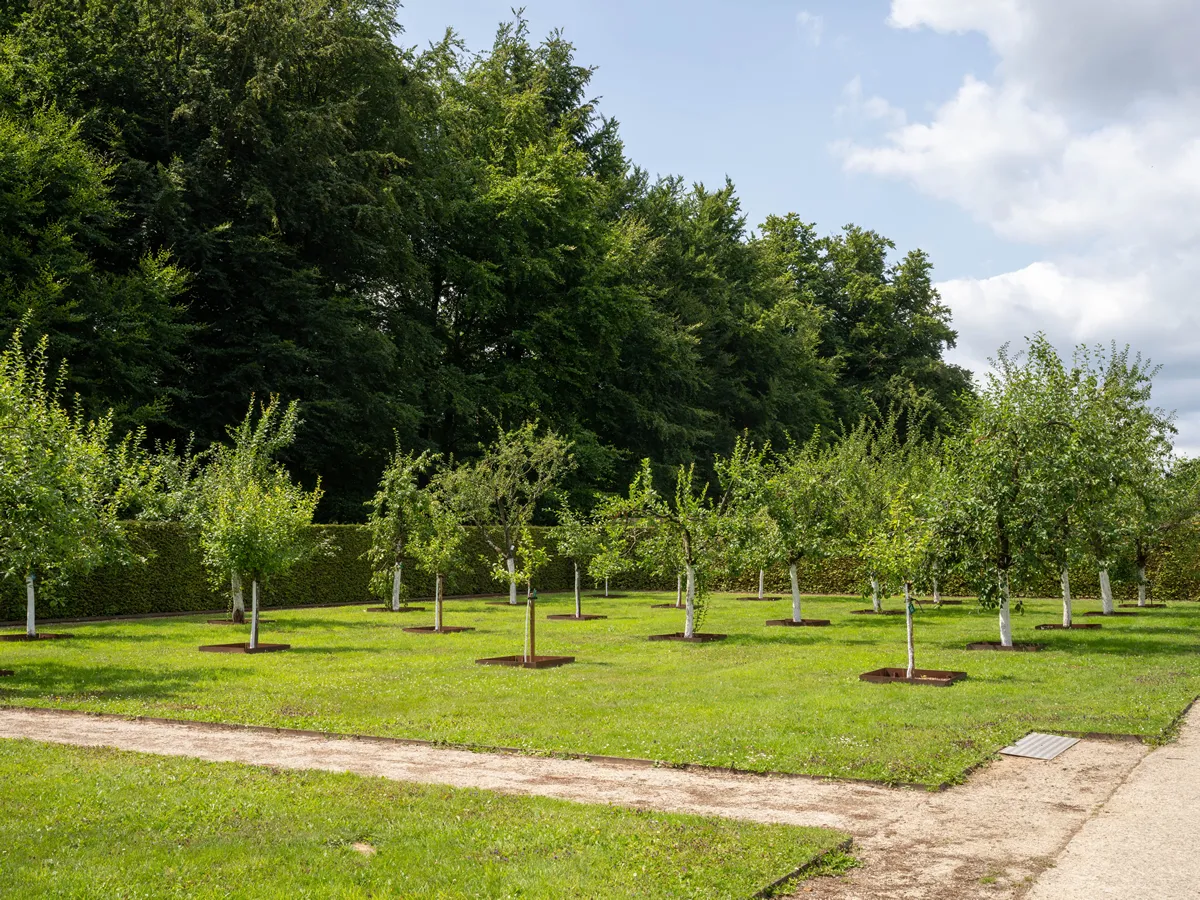 Grid plum trees in low stem fruit orchard with white trunk to protect from the sun
Grid plum trees in low stem fruit orchard with white trunk to protect from the sun
Before you start planting your plum tree, it's important to prepare the soil properly. The first step is to dig a hole that's at least twice as wide and deep as the root ball of your young tree. Once the hole's prepared, mix some compost and aged manure into the soil to help enrich it. This will provide your new plum tree with the essential nutrients it needs to grow.
Then, place your tree in the hole, making sure that the soil around it is well-compacted. Finally, water the tree thoroughly to help settle the soil and encourage root growth. By putting in the effort to prepare the soil, you'll set your plum tree up for a healthy and successful future.
Absolutely! Preparing the soil for planting a plum tree is a crucial step in ensuring your tree thrives. Here's a step-by-step guide:
- Step 1: Test Your Soil Before you begin, it's essential to understand your soil type. You can purchase a soil testing kit from a garden centre or online. Plum trees prefer well-drained soil with a pH level of 6.0-7.5.
- Step 2: Choose the Right Location Plum trees need a sunny spot to grow. They also need well-draining soil, so avoid areas where water collects after a heavy rain.
- Step 3: Clear the Area Remove any weeds, grass, or other plants from the area where you plan to plant your plum tree. These can compete with your tree for nutrients and water.
- Step 4: Dig the Hole The hole should be twice as wide and just as deep as the root ball of your tree. This gives the roots plenty of room to spread out.
- Step 5: Amend the Soil If your soil is heavy clay, mix in some organic matter like compost or well-rotted manure to improve drainage. If your soil is sandy, add organic matter to improve its ability to retain water and nutrients.
- Step 6: Fill the Hole Partially Place some of the amended soil back into the hole. This creates a cushion for the tree's roots and helps position the tree at the correct depth.
- Step 7: Place Your Tree Position your tree in the hole, ensuring that the top of the root ball is level with or slightly above the soil surface.
- Step 8: Backfill the Hole Fill in the hole with the amended soil, pressing down gently to eliminate air pockets.
- Step 9: Water Thoroughly Water your newly planted plum tree thoroughly to help settle the soil.
- Step 10: Mulch Apply a layer of organic mulch around the base of the tree to conserve moisture and suppress weeds. Ensure the mulch doesn't touch the trunk to prevent rot.
By following these steps, you'll create an ideal environment for your plum tree to thrive. Happy planting!
Watering Your Plum Tree Regularly
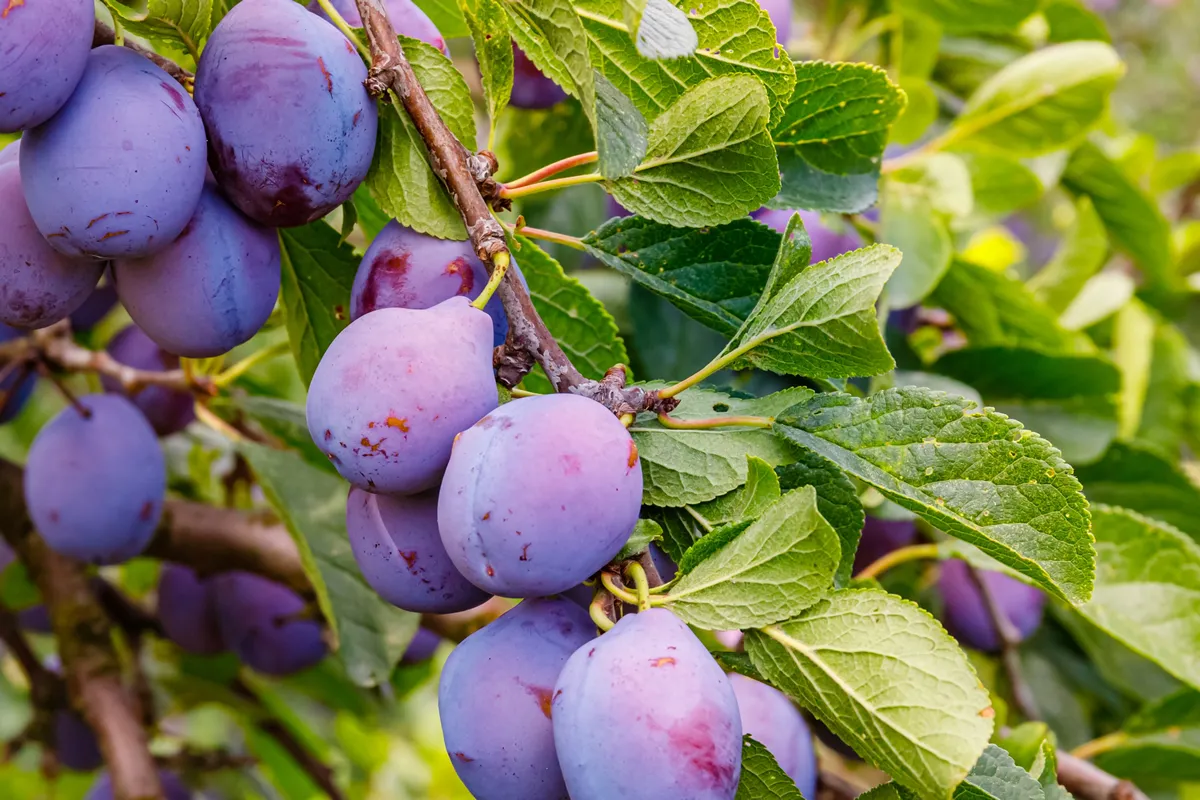 Many ripe plums in garden.
Many ripe plums in garden.
As the summer heat rises, it's important to remember to water your plum tree regularly. Plum trees are known for producing sweet and juicy fruit, but they require a consistent amount of water to thrive. Without sufficient moisture, the tree can become stressed and its fruit can suffer. By keeping the soil around the plum tree moist, you'll be ensuring that it receives enough water to grow strong and healthy.
So, next time you're out in the garden, grab your watering can and give your plum tree a good drink. Your taste buds will thank you come harvest time.
Watering needs for a plum tree can vary depending on its size, age, and the climate it's in. However, there are some general guidelines to follow:
- For Young Trees: Newly planted plum trees need consistent moisture to establish their root systems. Typically, a deep watering once or twice a week is recommended.
- For Established Trees: Once the plum tree is established (after a couple of years), it requires less frequent watering - about once every two weeks. During this time, deep watering is crucial to encourage roots to grow deep into the soil.
- During Dry Periods: In hot, dry periods, plum trees may need extra water. If the leaves start wilting or turning yellow, this might be an indication that the tree needs more water.
- Winter Watering: In winter, reduce watering significantly as the tree will be dormant and excess water can cause Root Rot.
- Method of Watering: Consider using soaker hoses or drip irrigation systems for watering as they deliver water directly to the roots and minimize evaporation.
Remember, overwatering can be as harmful as underwatering. The goal is to keep the soil moist but not waterlogged. Always check the soil moisture levels before watering, and adjust as necessary.
What is the Best Fertilizer Feed for a Plum Tree and When to Apply it?
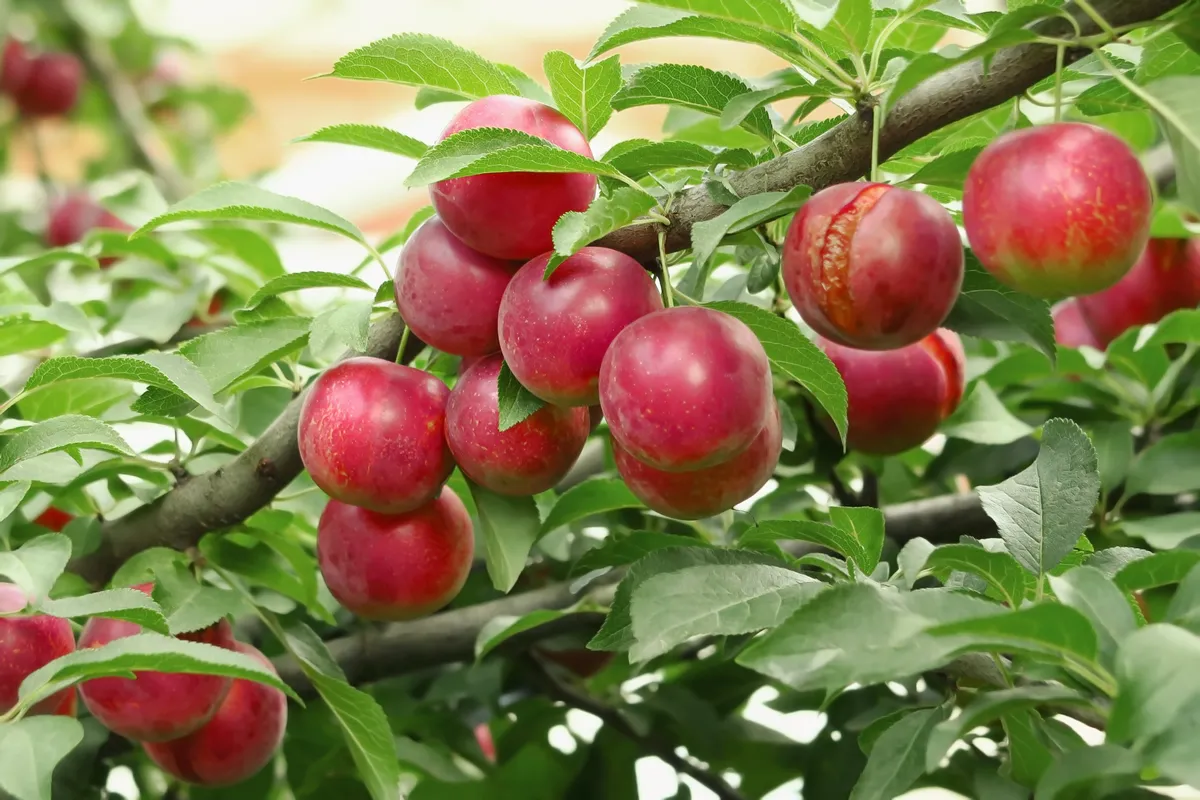 Ripe red plums on a plum tree branch
Ripe red plums on a plum tree branch
If you're lucky enough to have a plum tree in your yard, you want to make sure it's healthy and producing juicy, delicious fruit. One of the best ways to keep your tree healthy is by using fertilizer. But which fertilizer is best? The answer depends on your soil's pH and nutrient levels, but a general recommendation is a balanced fertilizer with a nitrogen-phosphorus-potassium (NPK) ratio of 10-10-10.
Apply the fertilizer in early spring, before the tree starts to grow new leaves, and again in late spring or early summer. Remember to follow the manufacturer's directions carefully to avoid over-fertilizing, which can harm your plum tree.
With the right fertilizer and timing, your plum tree will thrive and reward you with a bountiful harvest.
Choosing the right fertilizer for your plum tree can significantly impact its growth and fruit production. Here are some excellent options based on the information gathered:
- 10-10-10 Fertilizer: A balanced 10-10-10 fertilizer is often recommended for newly planted plum trees. It provides an equal ratio of Nitrogen, Phosphorus, and Potassium, essential nutrients that support overall plant health.
- Compost or Well-Rotted Manure: Organic options like compost or well-rotted manure not only provide nutrients but also improve soil structure and water-holding capacity. They're a great way to add micronutrients to the soil.
- High Nitrogen Fertilizer: Plum trees, like other fruit trees, prefer a high nitrogen fertilizer. Organic options include blood meal, soybean meal, or composted chicken manure.
- Fruit Tree Fertilizer: There are also specialized fruit tree fertilizers available on the market. These products are formulated with the specific nutrient needs of fruit trees in mind and often include micronutrients.
- Calcium Nitrate or Ammonium Nitrate: For established trees, a mid-May and mid-July application of calcium nitrate or ammonium nitrate can be beneficial.
Remember, the best fertilizer for your plum tree may depend on your specific soil conditions. It's always a good idea to conduct a soil test before applying any fertilizer to know what nutrients your soil might be lacking. Always follow package instructions when applying fertilizer to avoid over-fertilization.
When Do Plum Trees first start to Produce Fruit?
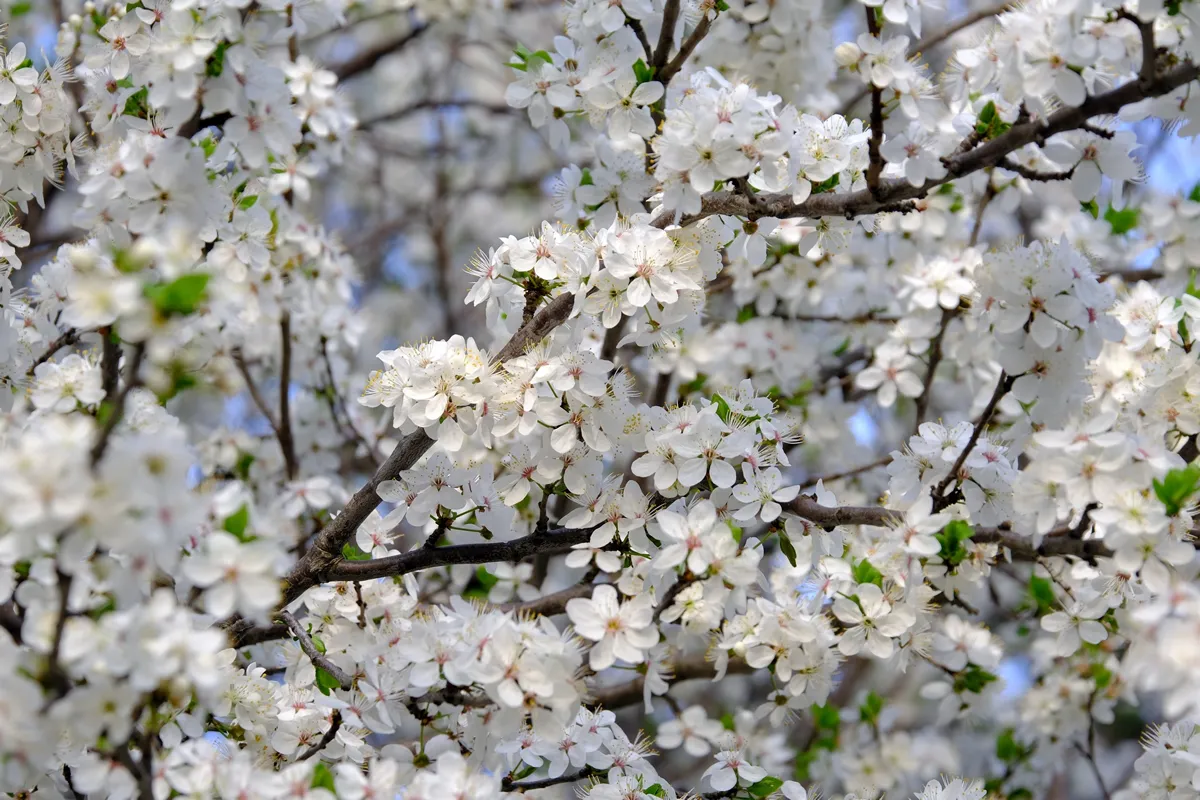 Flowering fruit tree in spring. White small flowers of Mirabelle plum, also known as mirabelle prune or cherry plum (Prunus domestica subsp. syriaca).
Flowering fruit tree in spring. White small flowers of Mirabelle plum, also known as mirabelle prune or cherry plum (Prunus domestica subsp. syriaca).
The plum tree is a beautiful addition to any garden, but many people wonder when it will start to bear fruit. The good news is that with proper care and attention, your plum tree will begin to produce fruit within three to five years of planting. This means that you can expect your tree to start providing juicy, delicious plums for your family to enjoy relatively quickly.
The key to getting your plum tree to produce fruit is to make sure it is planted in a sunny location with well-drained soil, and to take good care of it throughout the year. With a little bit of patience and attention, you'll soon be able to savour the sweet rewards of your beautiful plum tree.
How Fast do Plum Trees Grow
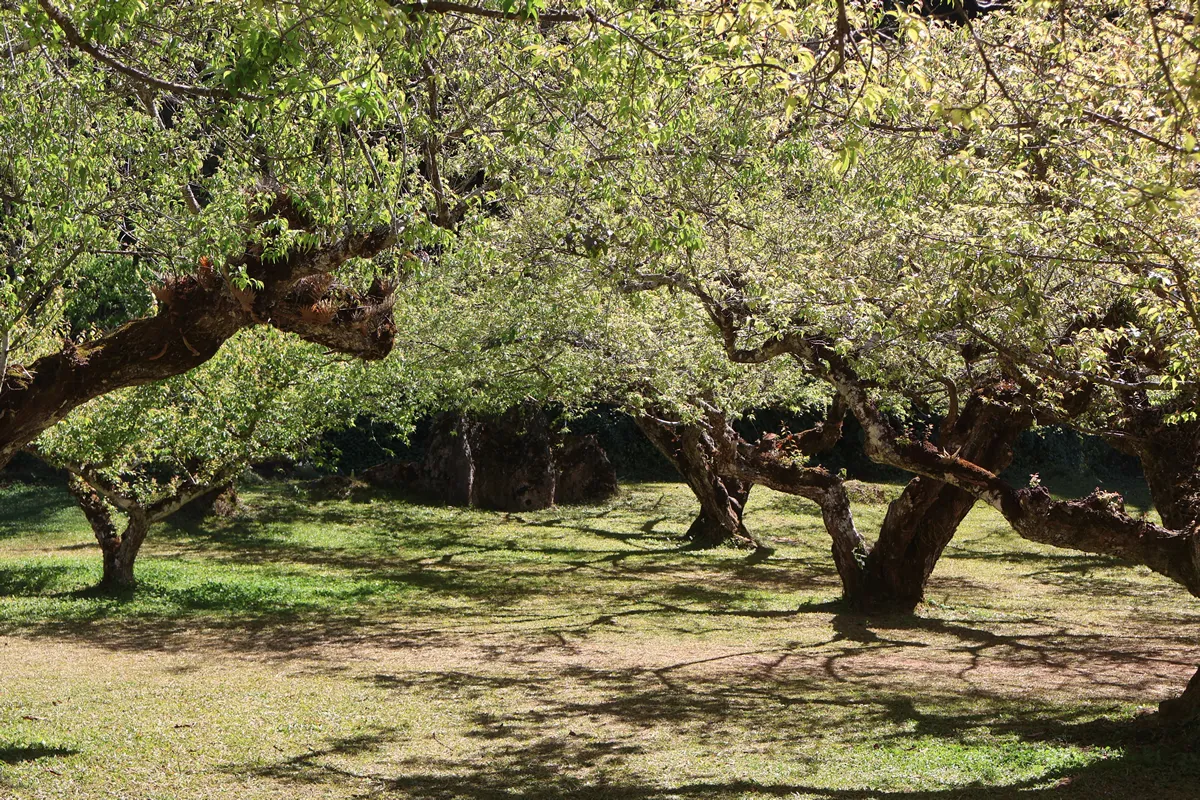 Plum trees in the sunshine day
Plum trees in the sunshine day
Plum trees are a popular addition to gardens and orchards because of their beautiful blooms and delicious fruits. But many people wonder, just how fast do plum trees grow? Well, that depends on a variety of factors such as the type of plum tree, soil quality, amount of sunlight, and water levels. Generally, plum trees can grow up to two feet per year if growing conditions are optimal.
However, it can take years for them to bear fruit, with some varieties taking up to five years. So, if you're considering adding a plum tree to your garden, make sure to choose a healthy sapling and provide it with the right conditions to ensure it grows strong and produces plenty of sweet and juicy plums!
How do you know When it is the right time to Harvest a Plum Tree?
 The blossoming plum tree. A branch of a plum tree with pink flowers. Flowering plum tree in spring.
The blossoming plum tree. A branch of a plum tree with pink flowers. Flowering plum tree in spring.
Plum trees can provide a bountiful harvest, but it's important to know when to pick the fruit. The best way to determine the right time to harvest your plum tree is by looking at the fruit itself. As it ripens, the fruit will change color from green to a deep purple or red.
Additionally, the fruit will give a little when you gently press it with your finger. If the fruit feels hard and unyielding, it's not yet ready to be harvested. However, if it's soft and plump, it's time to pick your delicious plums. With some patience and observation, you can ensure the perfect harvest from your plum tree.
What are the Best Preservation methods and storage of Plums
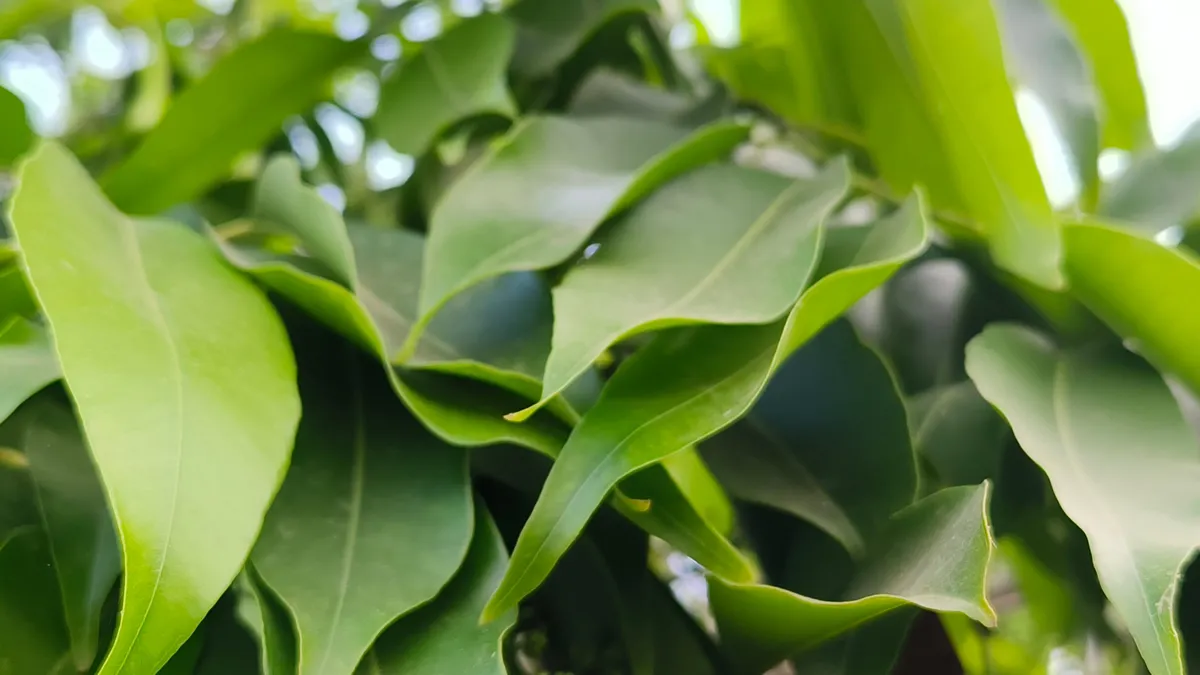 green leaves of Black Plum tree. Java Plum leaves.
green leaves of Black Plum tree. Java Plum leaves.
Harvesting fruit from your plum tree can be a wonderful experience, but it's important to take proper care to preserve and store your bounty. Luckily, there are a variety of effective preservation methods to keep your plums fresh and delicious for months to come. If you plan on eating or cooking with your plums within a few days, storing them in a cool, dry place will usually do the trick. For longer-term storage, consider freezing or canning your plums.
Freezing is particularly handy if you want to enjoy your plums in smoothies or baked goods later in the year, while canning is a great option for preserving your plums in syrup for a little taste of summer during the colder months.
Whatever method you choose, taking care to properly preserve and store your harvested plum tree fruit will help you enjoy it for months to come.
The Common Diseases and Pests which Affect the Plum Tree
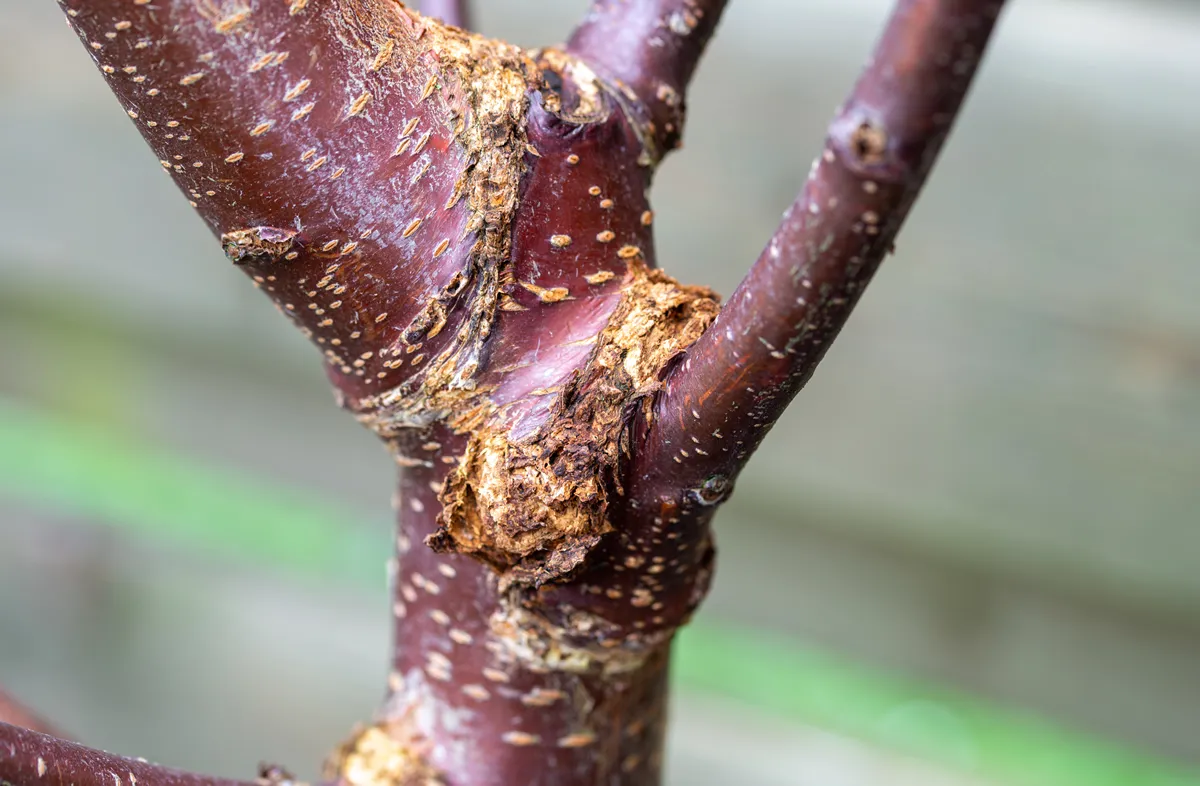 Sunken canker on trunk of tree, a common symptom of bacterial canker on sweet cherries tree Prunus avium 'Varikse Zwarte'
Sunken canker on trunk of tree, a common symptom of bacterial canker on sweet cherries tree Prunus avium 'Varikse Zwarte'
The plum tree is a beautiful addition to any garden or orchard, but unfortunately, it is vulnerable to a variety of diseases and pests. One of the most common diseases that afflict the plum tree is Black Knot, a fungal infection that causes black, warty growths on the branches and trunk of the tree. Other diseases that can impact the plum tree include peach leaf curl, bacterial canker, and Brown Rot.
Additionally, pests like plum curculio, Aphids, and Japanese Beetles all pose a threat to the health of the plum tree. As a fruit-bearing tree, it's important to take measures to protect your plum tree from these ailments to ensure a healthy harvest.
Certainly! Plum trees, like other fruit trees, can be susceptible to a range of diseases and pests. Here are some of the most common ones:
Diseases:- Black Knot: This disease is caused by the fungus Apiosporina morbosa. It causes black, knot-like growths on branches and trunks.
- Plum Pox Virus: Also known as Sharka, this viral disease causes yellow rings or spots on leaves and fruit.
- Brown Rot: Caused by the fungus Monilinia fructicola, it results in browning and rotting of the fruit, often with fluffy tan spore masses.
- Perennial Canker: This disease leads to sunken, dead areas of bark on the trunk or branches.
- Bacterial Leaf Spot: It causes dark spots on leaves, which can eventually turn yellow and drop.
- Silver Leaf Disease: This fungal disease causes a silver sheen on leaves and can lead to branch dieback.
- Aphids: These tiny insects suck sap from plum trees, causing curled and yellowed leaves.
- Pigeons: Pigeons can cause significant damage to fruit crops, including plums.
- Winter Moths: The caterpillars of these moths can defoliate trees in the spring.
- scale insects: These pests appear as small bumps on branches and can weaken trees by sucking sap.
- Plum Fruit Moth: The larvae of this moth burrow into ripening fruit, making it inedible.
It's important to regularly check your plum tree for signs of these diseases and pests. Early detection and intervention are key to managing them effectively and ensuring the health of your tree.
A Complete Guide to Pruning a Plum Tree in the UK
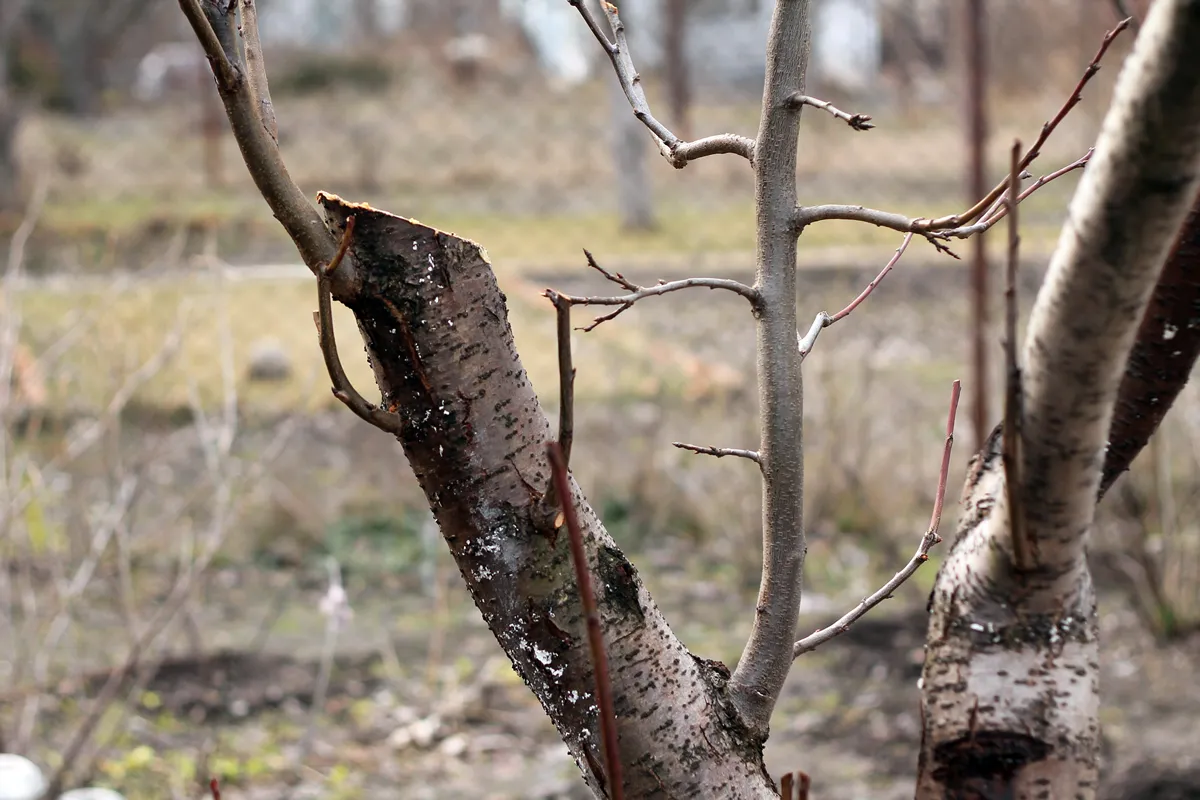 Rejuvenating pruning of old fruit tree - plum. Close up. On cut of old trunk, young twigs are visible. They grew up after pruning. These young twigs will be new skeletal branches of rejuvenated tree.
Rejuvenating pruning of old fruit tree - plum. Close up. On cut of old trunk, young twigs are visible. They grew up after pruning. These young twigs will be new skeletal branches of rejuvenated tree.
If you're lucky enough to have a plum tree in your garden in the UK, you may be wondering how to go about pruning it correctly. Pruning is an essential part of maintaining a healthy and productive fruit tree, but it can seem daunting if you're not sure where to start.
However, with a little bit of knowledge and some careful planning, you can successfully prune your plum tree to promote healthier growth and a bountiful harvest. In this guide, we'll take you through the basics of pruning a plum tree in the UK, from when to prune to how to make the right cuts.
By the end, you'll feel confident in your ability to keep your plum tree in top shape for years to come.
Why Do we Need to Prune a Plum Tree?
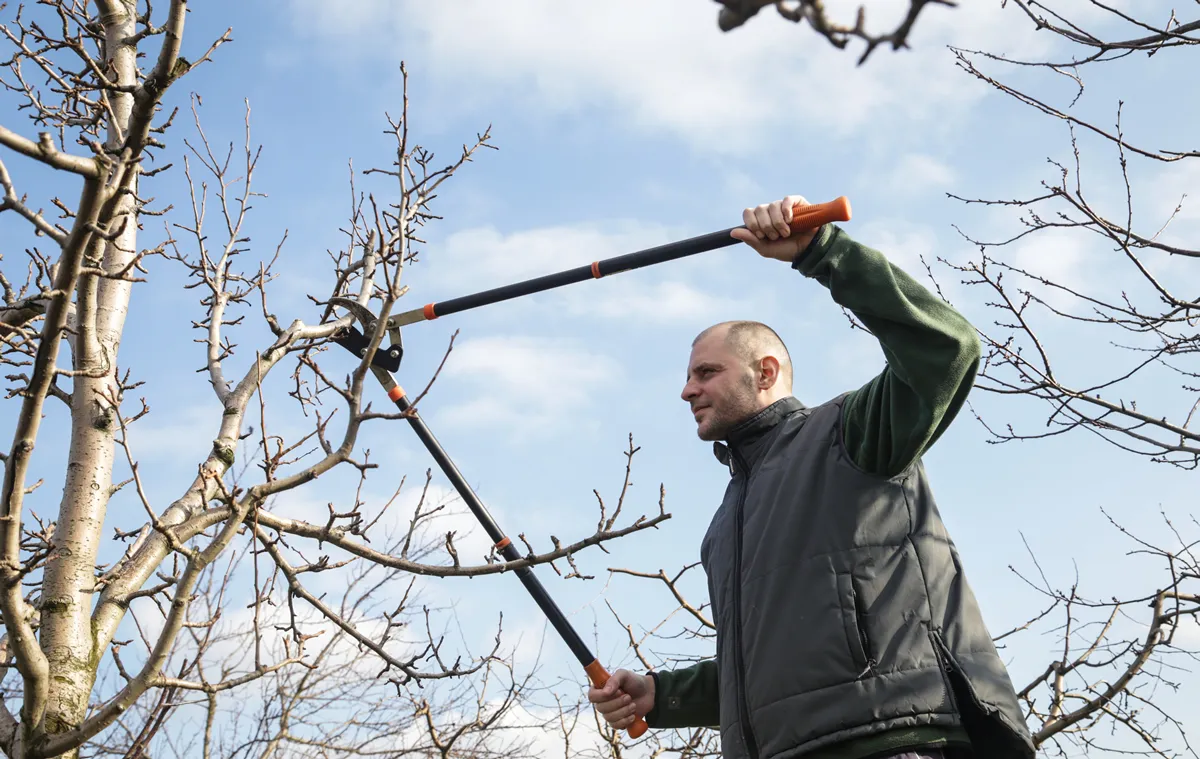 Tree pruning during sunny winter day
Tree pruning during sunny winter day
Pruning is an essential task for any fruit tree owner, and a plum tree is no exception. A properly pruned plum tree will not only promote healthier growth, but it will also lead to a higher yield of delicious plums. One of the main reasons for pruning a plum tree is to remove any damaged or diseased branches, which can spread to healthy parts of the tree and reduce crop yields.
Additionally, pruning can encourage the growth of new fruiting spurs, which are the branches that produce plums. By removing excess growth, you can direct the tree's energy towards producing healthy and juicy plums. Overall, pruning your plum tree is a necessary step to ensure a bountiful harvest for years to come.
When is the Best Time to Prune a Plum Tree?
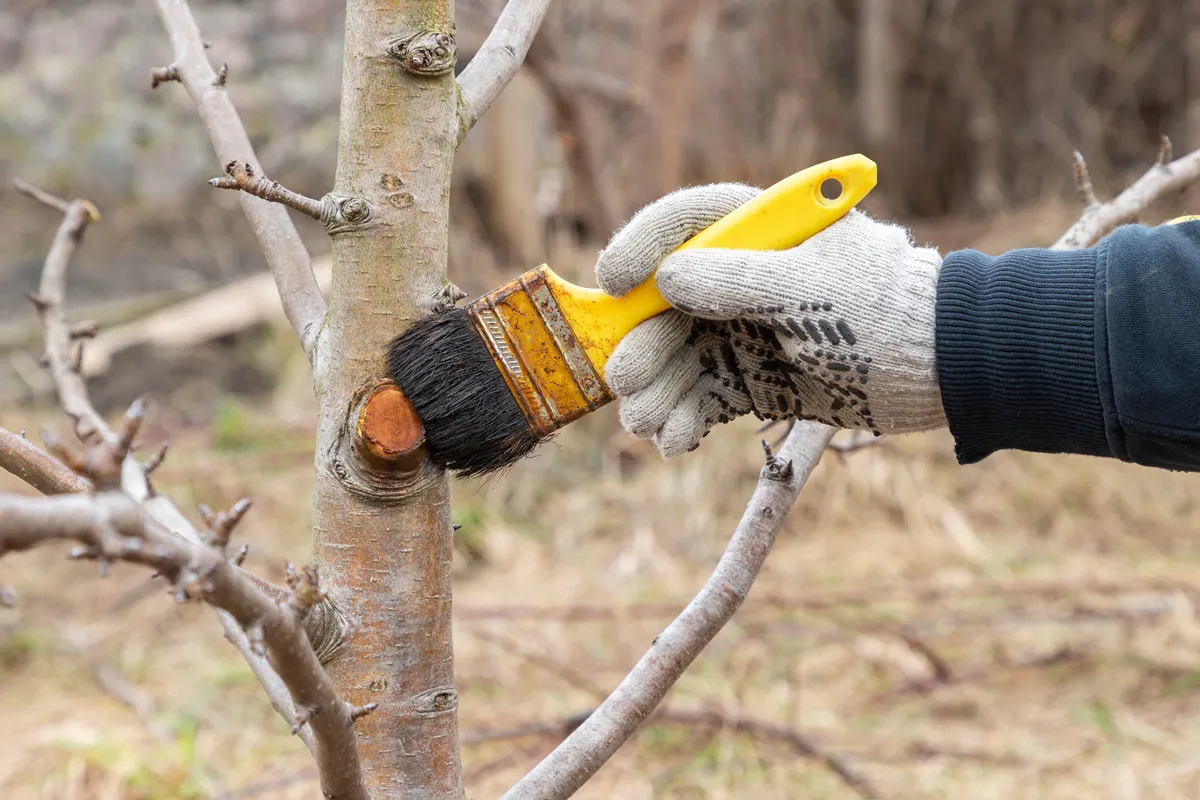 Gardener's hand smudging with brush with garden wax or wood tar wounds on the branches and trunks of fruit tree, berry trees, apple, plum for treatment, healing after cutting, sawing. Garden care.
Gardener's hand smudging with brush with garden wax or wood tar wounds on the branches and trunks of fruit tree, berry trees, apple, plum for treatment, healing after cutting, sawing. Garden care.
If you're looking to get the most delicious plums possible, it's important to know when the best time to prune your plum tree is. Typically, the best time to prune your plum tree is during the winter months when the tree is dormant, as it's easier to see the structure of the tree and make necessary cuts.
However, it's important to note that timing can vary depending on the region and climate conditions. The goal of pruning your plum tree is to remove any damaged or diseased branches as well as any suckers, which are branches that grow from the base of the tree. By removing these, you'll encourage the tree to focus its energy on producing healthy and juicy plums.
A Step by Step Guide on How to Prune a Plum Tree
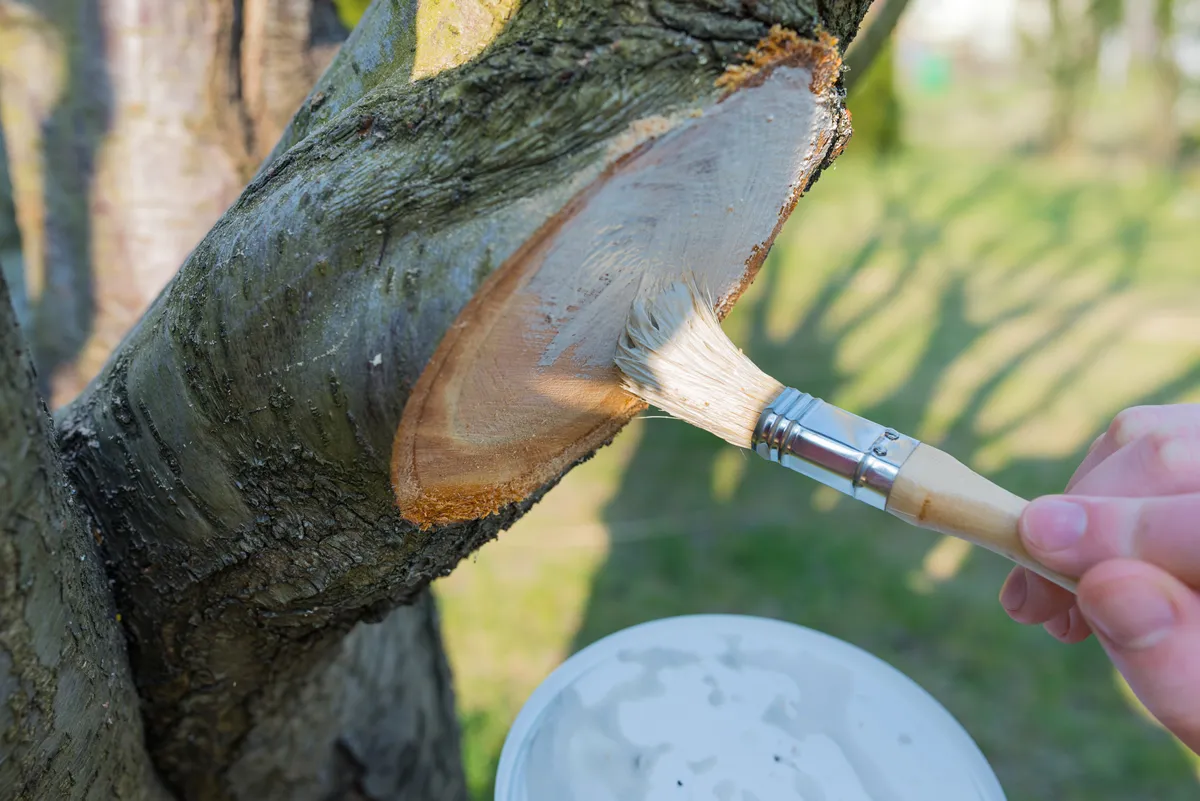 Protecting the pruned branch of the fruit tree - plum - with garden paste
Protecting the pruned branch of the fruit tree - plum - with garden paste
If you've got a plum tree in your garden, then learning how to prune it is essential in ensuring a bountiful harvest of juicy and delicious plums. Pruning involves cutting off certain parts of the tree to encourage new growth and promote healthier branches.
The first step is to ensure you have the right tools, such as pruning shears and a hand saw. Then, identify any dead, diseased, or damaged branches and remove them.
Next, thin out the tree by removing any branches that are growing too closely together or are crossing over each other.
Finally, shape the tree to encourage growth towards the centre of the canopy. With these simple steps, you'll be well on your way to a thriving plum tree and delicious fruit for years to come.
Pruning a plum tree is crucial for its health, productivity, and shape. Here's a step-by-step guide to help you through the process:
- Step 1: Choose the Right Time The best time to prune a plum tree is in early spring or mid-summer to minimise the risk of disease infection.
- Step 2: Gather Your Tools You'll need a pair of sharp secateurs, loppers for larger branches, and a pruning saw for the largest limbs. Ensure your tools are clean and sharp to make clean cuts and prevent disease spread.
- Step 3: Start with Damaged or Diseased Branches Begin by removing any branches that are dead, diseased, or damaged. Cut back to healthy wood, just above a bud or branching point.
- Step 4: Remove Crossing Branches Next, look for branches that are crossing or rubbing against each other. These can cause damage over time, so choose one to keep and remove the other.
- Step 5: Thin Out the Canopy To improve air circulation and sunlight penetration, remove some of the inner branches. This helps to reduce disease problems and promotes better fruiting.
- Step 6: Shorten Long Branches Long branches can become heavy with fruit and break, so it's a good idea to shorten them. Always cut back to a side branch or bud to avoid leaving stubs.
- Step 7: Maintain the Shape If your tree is becoming too tall or wide for your space, you can prune to maintain its shape. Remember to make your cuts just above a bud that's facing the direction you want the new growth to go.
- Step 8: Clean Up Once you're done pruning, collect and dispose of all the cut branches. If any were diseased, avoid composting them as this could spread the disease.
- Step 9: Monitor Your Tree After pruning, keep an eye on your tree. If you see signs of disease or pest activity, take action promptly.
Remember, it's better to under-prune than over-prune. It might take a few seasons to get your tree exactly how you want it, but gradual, careful pruning is much healthier for the tree. Happy pruning!
How Much can I Prune Away a Mature Plum Tree
 Green lawn with blossoming pink plum trees at Meadows park, Edinburgh.
Green lawn with blossoming pink plum trees at Meadows park, Edinburgh.
When it comes to pruning a mature plum tree, many gardeners find themselves in a dilemma. They want to keep the tree healthy and productive, but they don't want to go overboard and end up doing more harm than good. The truth is, there's no hard and fast rule when it comes to pruning a mature plum tree.
The amount of pruning required largely depends on the tree's age, health, and overall growth trajectory.
That being said, there are some general guidelines that can help you make the right decision. With a little bit of careful consideration, you can ensure that your plum tree remains a beautiful and fruitful addition to your garden for many years to come.
How to Care for a Plum Tree after Pruning
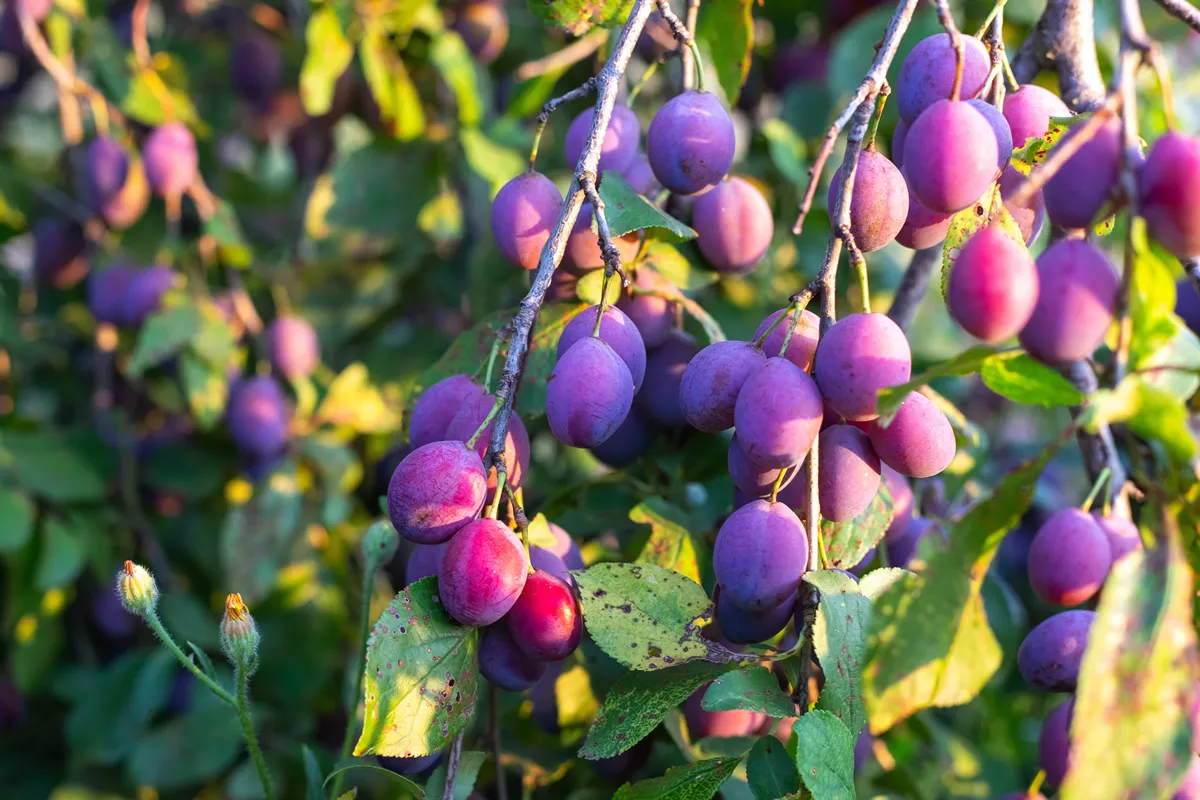 Delicious fragrant purple plums grow on a fruit tree branch on a summer sunny day in the garden. Rich harvest of fruits and berries.
Delicious fragrant purple plums grow on a fruit tree branch on a summer sunny day in the garden. Rich harvest of fruits and berries.
Caring for a plum tree after pruning is an essential step to ensure the growth of juicy and sweet fruits in the coming season. Pruning stimulates new growth, improves air circulation, and removes diseased or dead branches, promoting a healthier tree. After pruning, treat the tree with care by applying a protective coating to the pruning wounds to help the plant heal. Provide adequate water and nutrients to the tree, especially during the growing season, to promote healthy growth and prevent stress.
By following these simple care tips and techniques, you can enjoy a bountiful harvest from your plum tree.
Caring for a plum tree after pruning is crucial to help the tree recover and thrive. Here are some steps to follow:
- Step 1: Wound Dressing After pruning, you might be tempted to apply a wound dressing or paint to the cut surfaces. However, research has shown that trees heal best when wounds are left open to air.
- Step 2: Watering Pruning can be stressful for a tree, so ensure it gets plenty of water in the weeks following the pruning, especially if conditions are dry. But avoid overwatering as this can lead to root problems.
- Step 3: Mulching Apply a layer of organic mulch around the base of the tree to help conserve moisture and suppress weeds. Ensure the mulch isn't touching the trunk to prevent rot.
- Step 4: Fertilizing A few weeks after pruning, apply a balanced fertilizer to provide the nutrients the tree needs to recover and grow. If your soil is rich, additional fertilization may not be necessary.
- Step 5: Monitoring Keep an eye on your tree as it recovers from pruning. Watch for signs of disease or pest activity, particularly on the pruned branches. If you see anything concerning, consult with a local extension service or arborist.
- Step 6: Protection If you've pruned your plum tree significantly, it may need protection from sunscald or frost damage. You can wrap the trunk with a tree wrap or use a white tree guard to reflect the sun.
Remember, each plum tree is unique and may have specific care requirements based on its variety, age, health, and the local growing conditions. It's always a good idea to seek advice from a local horticulturist or arborist if you're unsure.
How to avoid Pruning too Much off my Plum Tree
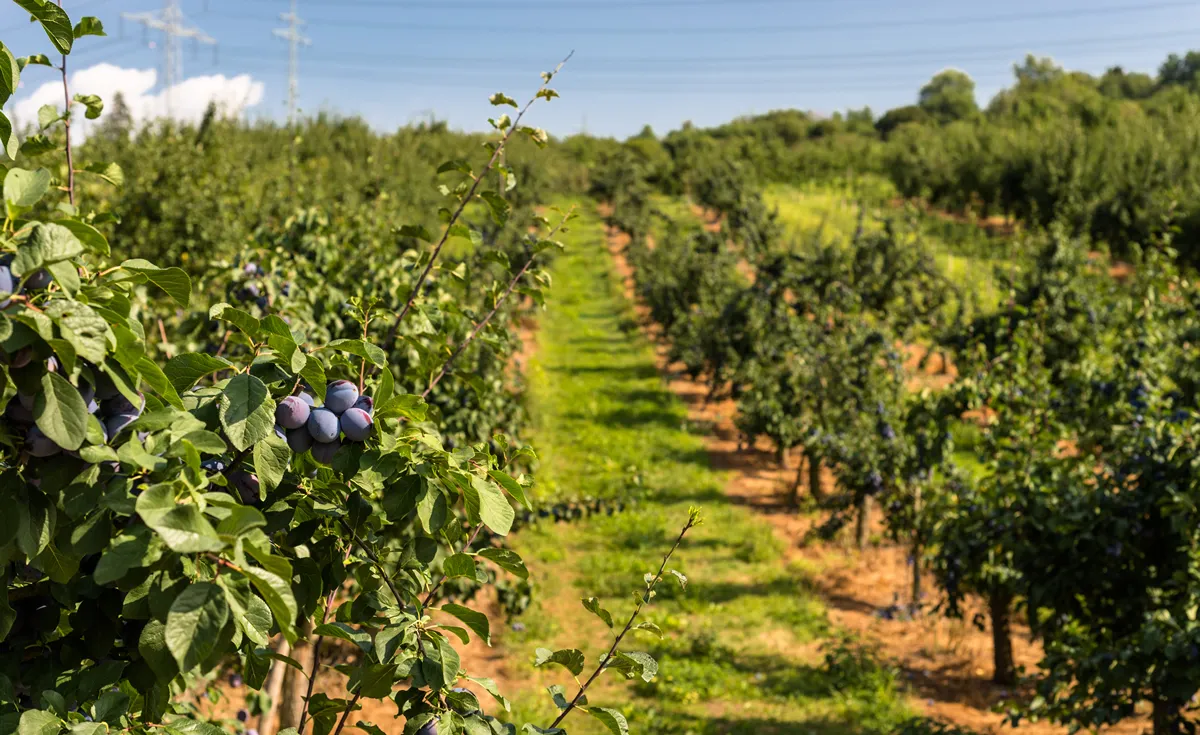 Fresh ripe blue violet plums on the branch in orchard on a beautiful summer day in western Germany.
Fresh ripe blue violet plums on the branch in orchard on a beautiful summer day in western Germany.
Taking care of a fruit tree can be a rewarding experience, but pruning it wrongly can lead to frustration. When it comes to your plum tree, it's important to remember that less is often more. Pruning can help with fruit production and overall health of the tree, but it's crucial to avoid going overboard. One key thing to keep in mind is timing - prune in late winter or early spring before new growth starts.
Another tip is to focus on removing the 3 D's - dead, damaged, and diseased branches - to clear space for healthy growth. It's also wise to avoid heavy pruning of the central trunk or main branches as this can impact the overall structure of the tree.
With a little care and attention, you can keep your plum tree healthy and fruitful for years to come.
What to Do if my Plum Tree stops Producing Fruit
 Mayongchid Maprang Marian Plum and Plum Mango thailand
Mayongchid Maprang Marian Plum and Plum Mango thailand
As a proud owner of a plum tree, it can be disheartening if it suddenly stops producing fruit. However, there are steps you can take to help your tree thrive once again. First, assess the health of the tree. Are the leaves turning yellow or brown? Is there any damage to the trunk or branches? If so, address these issues by pruning back any diseased or dead branches and providing proper irrigation and fertilization.
Additionally, check for any pest infestations, such as plum curculio, and treat accordingly. Another factor to consider is the age of the tree; most plum trees begin to decline after 10-15 years. In this case, it may be time to replant a younger tree.
By taking the necessary measures, your plum tree can continue to provide delicious fruit for years to come.
An Overview of Pruning a Plum Tree
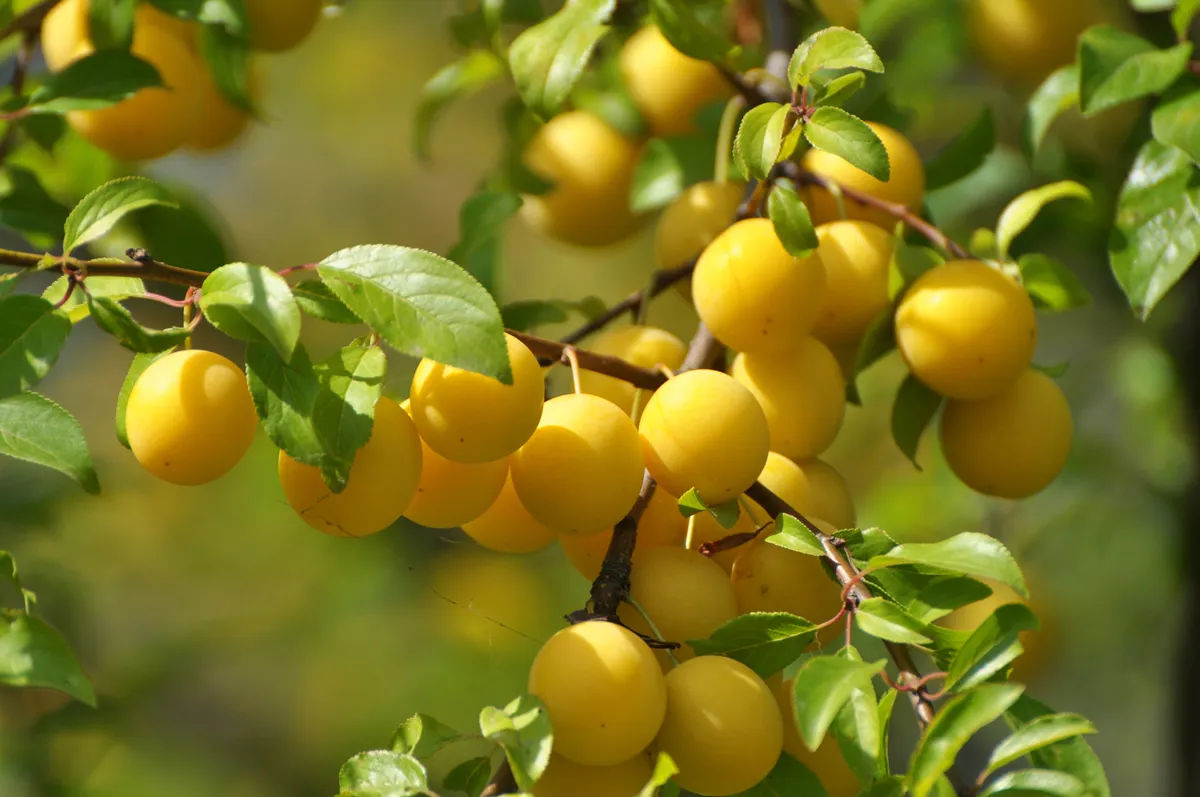 On the branches of the tree ripen fruits of plums (Prunus cerasifera).
On the branches of the tree ripen fruits of plums (Prunus cerasifera).
A plum tree can be a delightful addition to any yard, offering not only a beautiful sight but also delicious fruit. However, to maintain its health and productivity, pruning is essential. Pruning a plum tree involves removing dead, damaged or diseased wood, shaping the tree to improve its structure and allow enough sunlight to reach all parts of the tree. With the right knowledge and tools, pruning can be done safely and effectively.
While it may seem like a daunting task, taking care of your plum tree with regular pruning can make a big difference in its growth and overall appearance.
Growing a Plum Tree in a Pot or Container
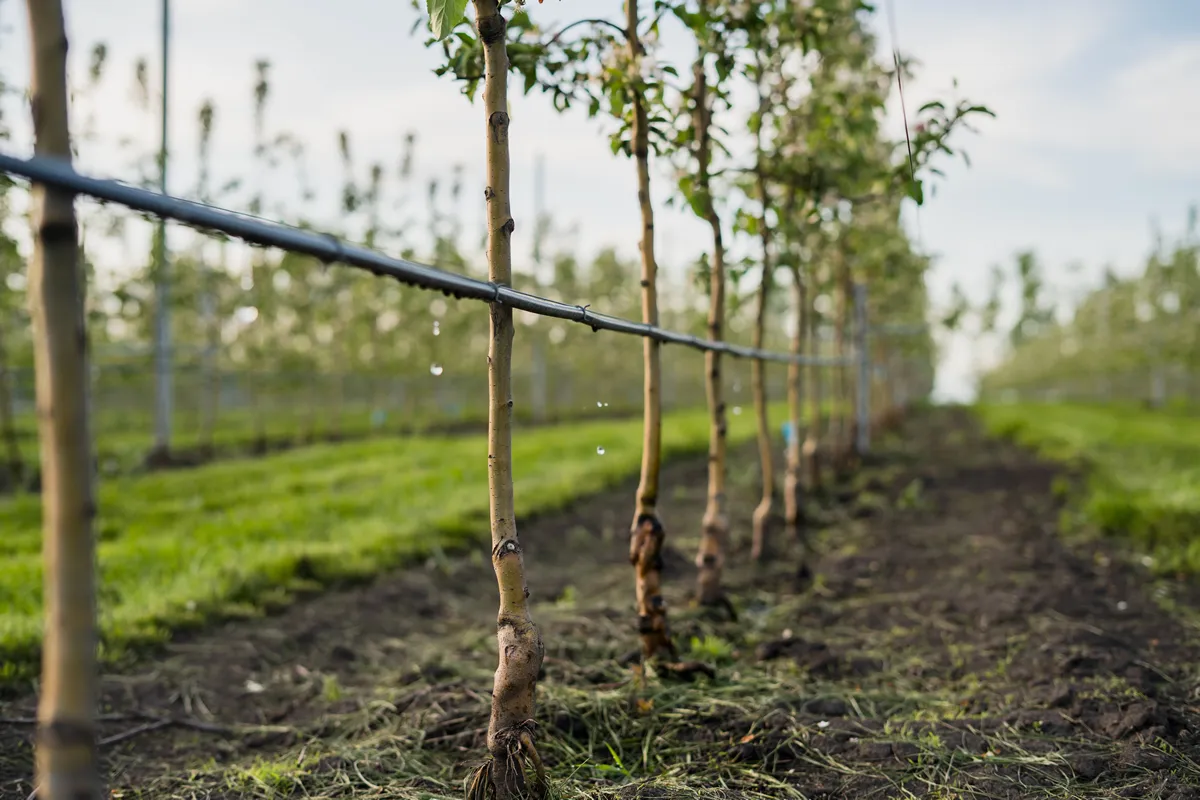 Using drip irrigation in a young apple tree garden
Using drip irrigation in a young apple tree garden
Are you interested in growing your own plug tree but limited on outdoor space? Fear not, for growing a plug tree in a pot or container is possible and relatively easy. First, select a pot that is at least two to three times larger than the root ball of your plug tree. Fill the pot with a well-draining potting mix, and position the tree in the center.
Remember to keep the tree watered, as potted plants often dry out quicker than those planted in the ground. Also, prune the tree regularly to help it maintain its shape and size. In no time, you'll have a beautiful plug tree thriving in its new container home.
Growing a plum tree in a pot or container can be a rewarding project, especially if you're short on space. Here's a step-by-step guide:
- Step 1: Choose the Right Variety Some plum varieties are more suited to container growing than others. Dwarf or miniatures are ideal. Examples include 'Black Amber', 'Dwarf Pixy', and 'Victoria'.
- Step 2: Select a Container Choose a large container with good drainage holes. A pot that's around 24-30 inches in diameter is a good starting point.
- Step 3: Prepare the Container Add a layer of broken pottery or gravel at the bottom of the pot for added drainage. This helps prevent waterlogging.
- Step 4: Choose the Right Soil Fill the pot with a good quality compost mixed with some perlite or sand to improve drainage.
- Step 5: Planting Place your plum tree in the pot, ensuring it's at the same depth it was in its previous pot. Fill the rest of the container with your compost mix, pressing down gently to remove any air pockets.
- Step 6: Watering Water thoroughly after planting, and continue to water regularly. The soil should be kept moist, but not soggy.
- Step 7: Positioning Place the pot in a sunny position. Plum trees need at least 6 hours of sunlight each day to produce fruit.
- Step 8: Feeding Feed your plum tree every two weeks during the growing season with a high potassium liquid feed to promote fruit production.
- Step 9: Pruning Prune your plum tree in summer to maintain its shape and size. Remember, pruning also encourages better fruiting.
- Step 10: Overwintering In colder regions, move your plum tree to a sheltered location or greenhouse over winter to protect it from frost.
By following these steps, you can enjoy your very own home-grown plums, even in the smallest of spaces. Happy gardening!
The humble plum tree is a great addition to any garden, offering years of delight and delicious crops. From selecting the right kind for UK climates, sowing from seed, propagating to ensure new generations of fruit bearing trees, preparing the soil adequately and watering regularly, you can soon find yourself in a beautiful orchard of plump fruiting trees. With such a vast variety of species, you can be sure to reach peak-harvest season from late July to early August. It is important to keep an eye on your tree’s growth and health as different varieties of plum tree will develop fruit at various rates and mature over several years. Each step of the way should be savored with curiosity for its delightful rewards once established! Whether for jams and jellies, pies or simply eaten fresh off the branch – nothing beats the pleasure of harvesting sweetly juicy plums from your own treasured trees.
How to Prune Climbing Vines
List by Variety
- How to Prune Actinidia
- How to Prune Akebia
- How to Prune Bougainvillea
- How to Prune Campsis
- How to Prune Celastrus
- How to Prune Chilean Glory Vine
- How to Prune Clematis Armandii
- How to Prune Clematis Montana
- How to Prune Climbing Rose
- How to Prune Hedera GoldHeart
- How to Prune Honeysuckle
- How to Prune Hydrangea Petiolaris
- How to Prune Ivy
- How to Prune Japanese Wisteria
- How to Prune Morning Glory
- How to Prune Parthenocissus
- How to Prune Persian Ivy Hedera Colchica
- How to Prune Schisandra
- How to Prune Star Jasmine
- How to Prune Sweet Peas
- How to Prune True Jasmine
- How to Prune Virginia Creeper
- How to Prune Wisteria
How to Prune Hedges
List by Variety
- How to Prune an Arborvitae Hedge
- How to Prune a Barberry Hedge
- How to Prune a Beech Hedge
- How to Prune a Boxwood Hedge
- How to Prune a Butterfly Bush Hedge
- How to Prune a Cotoneaster Hedge
- How to Prune an English Lavender Hedge
- How to Prune an Escallonia Hedge
- How to Prune an Euonymus-Hedge
- How to Prune a Firethorn Hedge
- How to Prune a Forsythia Hedge
- How to Prune a Griselinia Hedge
- How to Prune a Hawthorn Hedge
- How to Prune a Holly Hedge
- How to Prune a Hornbeam Hedge
- How to Prune a Laurel Hedge
- How to Prune a Leylandii Hedge
- How to Prune a Lilac Hedge
- How to Prune a Maple Leaf Viburnum Hedge
- How to Prune a Photinia Hedge
- How to Prune a Pink Ramanus Rose Hedge
- How to Prune a Privet Hedge
- How to Prune a Pyracantha Hedge
- How to Prune a Spirea Hedge
- How to Prune a Thuja Hedge
- How to Prune a Viburnum Hedge
- How to Prune a Western Red Cedar Hedge
- How to Prune a Yew Hedge
How to Prune Shrubs
List by Variety
- How to Prune an Abelia Shrub
- How to Prune an Abutilon
- How to Prune an Acer / Japanese-Maple
- How to Prune an Amelanchiers
- How to Prune an Apple-Tree
- How to Prune an Arbovitae Shrub
- How to Prune an Arbutus
- How to Prune an Aucuba
- How to Prune a Azalea Mollis
- How to Prune Azaleas
- How to Prune a Bay Tree Shrub
- How to Prune a Berberis Darwinii
- How to Prune Berberis Deciduous Types
- How to Prune a Boxwood Shrubs
- How to Prune a Brachyglottis Senecio
- How to Prune a Buddleia Alternifolia
- How to Prune Buddleias Butterfly Bushes
- How to Prune a Buddleja Globosa
- How to Prune a Callicarpa
- How to Prune a Camellia
- How to Prune a Caryopteris
- How to Prune a Catalpa Bignonioides Aurea
- How to Prune Ceanothus Deciduous Types
- How to Prune Ceanothus Evergreen Types
- How to Prune a Ceratostigma
- How to Prune a Chaenomeles
- How to Prune a Choisya
- How to Prune a Cistus
- How to Prune a Clematis
- How to Prune a Cornus
- How to Prune a Cotinus Royal Purple
- How to Prune a Cytisus Scoparius
- How to Prune a Exochorda x Macrantha
- How to Prune a Forsythia
- How to Prune a Hebe
- How to Prune a Hydrangeas
- How to Prune Juniper Shrubs
- How to Prune a Lavatera
- How to Prune Lilac Bushes
- How to Prune a Mugo Pine
- How to Prune Rose Bushes
- How to Prune Spirea Shrubs
- How to Prune Viburnum Shrubs
- How to Prune a Weigela
- How to Prune a Yew
How to Prune Trees
List by Variety
- How to Prune a Apple Tree
- How to Prune a Apricot Tree
- How to Prune a Ash Tree
- How to Prune a Birch Tree
- How to Prune a Cherry Tree
- How to Prune a Elm Tree
- How to Prune a Fig Tree
- How to Prune a Grape Tree
- How to Prune a Hickory Tree
- How to Prune a Maple Tree
- How to Prune a Oak Tree
- How to Prune an Olive Tree
- How to Prune a Peach Tree
- How to Prune a Pear Tree
- How to Prune a Plum Tree
- How to Prune a Poplar Tree
- How to Prune a Walnut Tree
Pests and Diseases
- How to Protect from Anthracnose
- How to Protect from Athids
- How to Protect from Apple Scab
- How to Protect from Armillaria Root Rot
- How to Protect from Bagworms
- How to Protect from Black Knot
- How to Protect from Black Rot
- How to Protect from Black Spot
- How to Protect from Botryosphaeria Dieback
- How to Protect from Botrytis Blight
- How to Protect from Brown Rot
- How to Protect from Canker Diseases
- How to Protect from Caterpillars
- How to Protect from Cedar Apple Rust
- How to Protect from Clematis Wilt
- How to Protect from Codling Moths
- How to Protect from Crown Gall
- How to Protect from Crown Rot
- How to Protect from Downy Mildew
- How to Protect from Dutch Elm Disease
- How to Protect from Elm Bark Beetle
- How to Protect from Elm Leaf Beetle
- How to Protect from Fire Blight
- How to Protect from the Gypsy Moth Caterpillars
- How to Protect from Honey Fungus
- How to Protect from Japanese Beetles
- How to Protect from Juniper Scale
- How to Protect from Lace Bugs
- How to Protect from Lacewings
- How to Protect from Leaf Miners
- How to Protect from Leaf Spot Diseases
- How to Protect from Mealybugs
- How to Protect from Needle Blight
- How to Protect from Oak Borers
- How to Protect from Oak Wilt
- How to Protect from Olive Knot Disease
- How to Protect from Peach Leaf Curl
- How to Protect from Peach Scab
- How to Protect from Pear Psylla
- How to Protect from Pear Rust
- How to Protect from Pear Scab
- How to Protect from Perennial Canker
- How to Protect from Pine Sawflies
- How to Protect from Pine Shoot Beetle
- How to Protect from Plum Fruit Moth
- How to Protect from Plum Pox Virus
- How to Protect from Poplar Borer
- How to Protect from Powdery Mildew
- How to Protect from Root Rot
- How to Protect from Rose Rosette Disease
- How to Protect from Rust Fungi
- How to Protect from Scale Insects
- How to Protect from Silver Leaf Disease
- How to Protect from Slugs
- How to Protect from Spider Mites
- How to Protect from Twig Blight
- How to Protect from Verticillium Wilt
- How to Protect from Viburnum Beetle
- How to Protect from Vine Weevil
- How to Protect from Walnut Blight
- How to Protect from Walnut Husk Fly
- How to Protect from Walnut Scale
- How to Protect from Western Flower Thrips
- How to Protect from Whiteflies
Popular Pruning Sections

General Pruning
General Information on How to Prune your Garden
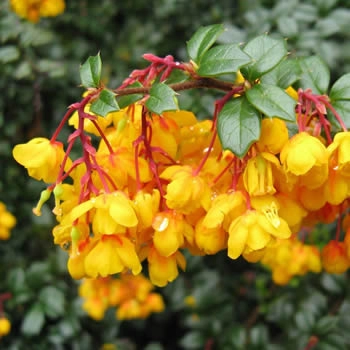
Pruning Shrubs
The Most Read Shrubs to Prune
- How to Prune Hydrangeas
- How to Prune a Rose Bush
- How to Prune Azaleas
- How to Prune a Lilac Bush
- How to Prune Buddleias - Butterfly Bushes
- How to Prune Forsythia
- How to Prune Weigela
- How to Prune Hebe
- How to Prune Camellia

Pruning Trees and Climbers
The Most Read Trees to Prune
- How to Prune Apple Trees
- Pruning Plum Trees
- Pruning Cherry Trees
- Pruning Olive Trees
- How to Prune a Grape Vine
- Acer Pruning | Pruning Japanese Maple
- How to Prune a Fig Tree
- Pruning Peach Trees
- Pruning Pear Trees
- How to Prune a Plum Tree

